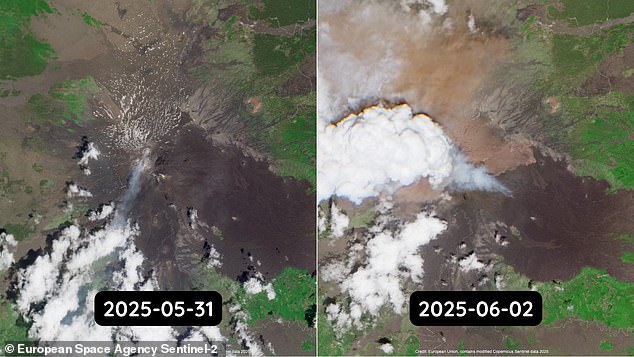
Satellite Images Capture Mount Etna Spewing 4-Mile Ash Plume as Tourists Flee Eruption
Mount Etna Erupts: Tourists Flee as Ash and Lava Engulf Sicily
Europe’s most active volcano, Mount Etna, unleashed a dramatic eruption on June 3, sending tourists scrambling to safety and spewing a colossal ash plume four miles (6.5 km) into the sky. Satellite images from Copernicus Sentinel-2C captured the eruption’s immediate aftermath, revealing pyroclastic flows and glowing lava streams racing down the slopes.
A Terrifying Spectacle
The eruption began at 11:24 a.m. local time when the southeastern crater partially collapsed, triggering a pyroclastic flow—a fast-moving avalanche of ash, gas, and rock. Before-and-after satellite photos show a stark contrast, with thick ash blanketing the area. A “pyrocumulus” cloud, formed by volcanic heat, loomed above the eruption. Infrared imagery highlights intense lava flows snaking into the Valle del Bove.
[Insert: Satellite before/after images showing ash plume expansion.]
Tourists near the summit captured videos of booming explosions and the ash column billowing upward. Terrified hikers fled as the cloud surged. Authorities confirmed the pyroclastic flow diverted away from populated zones, posing “no danger” to nearby towns.
How the Eruption Unfolded
Dr. Teresa Ubide, a volcanologist, explained that pressure buildup in Etna’s gases caused the crater collapse, releasing the deadly pyroclastic flow. These flows, reaching 1,000°C (1,830°F) and speeds of 60 mph (100 km/h), are highly destructive. Fortunately, this event remained contained.
[Insert: Thermal image of lava flows in Valle del Bove.]
Lava soon followed, splitting into three streams flowing south, east, and north. Satellite thermal imaging tracked the molten rock’s path. Despite a brief red aviation alert for ash, no flights were disrupted.
Aftermath and Historical Context
By evening, seismic activity subsided, suggesting the eruption phase had ended. However, Mount Etna remains unpredictable. The 10,800 ft (3,300 m) volcano has erupted 14 times since 2023, including a 2023 event that forced Catania Airport closures due to ash. Historically, Etna’s 1669 eruption killed 20,000 people—a stark reminder of its power.
[Insert: Footage of tourists fleeing ash cloud.]
Why Monitoring Matters
While no casualties occurred this time, experts stress vigilance. Signals like increased seismic activity, gas emissions, and ground deformation help predict eruptions. Copernicus satellites play a key role in tracking hazards globally.
[Insert: Lava streams splitting into branches (infrared image).]
Though Etna’s latest spectacle ended without harm, it underscores the raw force of nature—and the importance of preparedness.
Word Count: ~550


